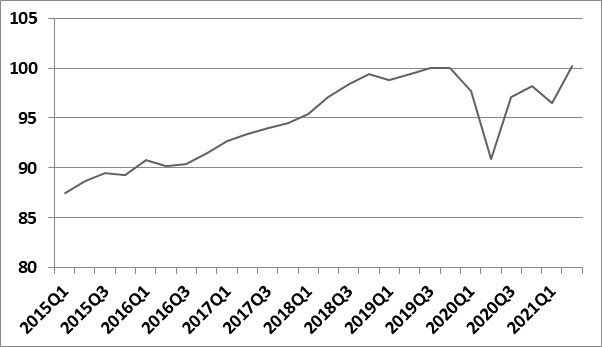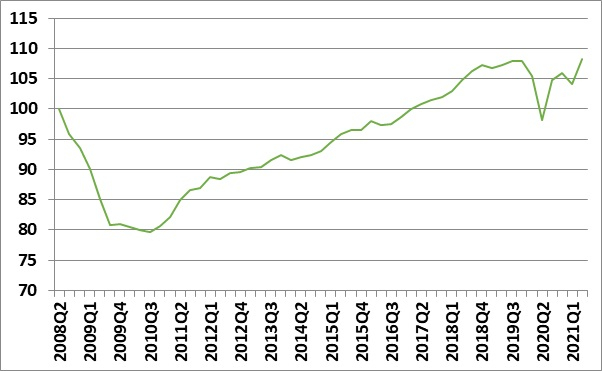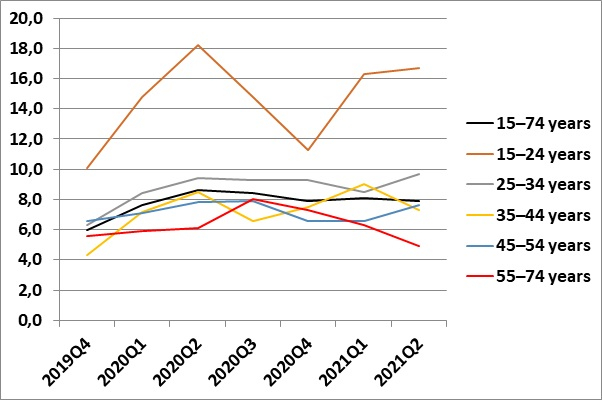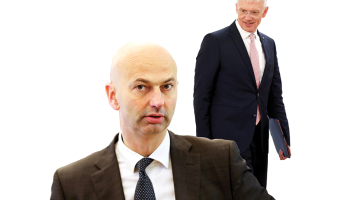
Ilustratīvs attēls
These two crises for the economy had completely different origins but it nevertheless makes sense to draw some comparisons – and now, after about a year and a half – we finally have a good handful of GDP data for this purpose.
With the lockdown taking place in March 2020, we can say that the fourth quarter of 2019 was the last “normal”, i.e. non-corona quarter, for the Latvian economy. I have recalibrated quarterly data for Latvian GDP to let 2019 Q4 = 100, see Figure 1.
Figure 1: Latvian GDP, quarterly data, 2015 Q1 – 2021 Q2; 2019 Q4 = 100
Source: Official statistics portal of Latvia and own calculations
Following the lockdown in March 2020 the economy took a nosedive and at the end of the 2nd quarter of 2020, i.e. just some four month after the lockdown, GDP had dropped by almost 10%, see again Figure 1, and shaved away all GDP growth since 2017 Q2. A super-sharp but also very short downturn since the economy started growing again in the 3rd quarter of 2020 and, with the recent flash estimate for GDP for 2021 Q2, the economy is now larger (just a tad…) than before corona and is set to grow further.
A comparison with the financial crisis is like comparing day and night. Let the equivalent to the corona lockdown be the bankruptcy of Lehman Brothers on 15 September 2008. Then the last “normal” quarter before the financial crisis was 2008 Q2. Recalibrate that quarter’s GDP to 100 and we get a development as seen in Figure 2.
Figure 2: Latvian GDP, quarterly data, 2008 Q2 – 2021 Q2; 2008 Q2 = 100
Source: Official statistics portal of Latvia and own calculations
In those dark days GDP decline bottomed out after 9 quarters and GDP did not regain its 2008 Q2 level until 2017 Q2, a full nine (!) years later – partly due the figure of 2008 Q2 being so inflated by the big boom preceding the financial crisis, partly due to substantial outward migration following the financial crisis: GDP had to be created with significantly fewer hands.
Another major difference between the two crises is the impact on unemployment. During the financial crisis the unemployment rate exploded to more than 20%; not so this time as can be seen (if one looks carefully, I shall admit, in Figure 3. It’s the black line).
Figure 3: Unemployment rates among different age groups in Latvia, 2019 Q4 – 2021 Q2
Source: Official statistics portal of Latvia
Although the unemployment rate now stands at 7.9%, just 1.9 percentage points above its 2019 Q4 value, different age groups have been hit differently with the younger groups suffering the most.
I am not sure if this fact has featured that prominently in the debate but while we shall be happy for a rather minimal (and short-lived, it seems) impact on unemployment rates it is somewhat sad that the ones affected the most are more likely the ones who have the biggest problems affording it.
That said, mitigation of the effects on unemployment by corona have been done by early action at both the domestic political level, at the EU level and via the ECB’s monetary policy. Not bad.
A brief conclusion: We are all heavily affected by the corona crisis but it has had more impact on our daily routines and perhaps our mental health than it has affected the economy. OK, fingers crossed that no super-contagious omega strain of the virus suddenly appears….
Morten Hansen is Head of Economics Department at Stockholm School of Economics in Riga and Vice-Chairman of the Fiscal Discipline Council of Latvia

















